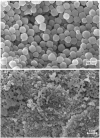Targeted Delivery of Lidocaine in Breast Cancer Cells via Zeolitic Imidazolate Framework-8 Nanoparticles
- PMID: 40556462
- PMCID: PMC12388163
- DOI: 10.1002/cphc.202401128
Targeted Delivery of Lidocaine in Breast Cancer Cells via Zeolitic Imidazolate Framework-8 Nanoparticles
Abstract
The aim of this article is to use zeolitic imidazolate framework-8 (ZIF-8) metal-organic frameworks (MOFs) as drug delivery system for lidocaine, a local anesthetic with recently discovered antitumoral effects, in particular for the early-stage treatment of breast cancer. A previously optimized ZIF-8 synthetic method is employed, and the prepared material is deeply characterized with X-ray powder diffraction (XRPD), surface area analysis, scanning electron microscopy (SEM), and thermogravimetric analysis (TGA). After confirming the successful synthetic outcomes, a tailored loading procedure is developed to incorporate lidocaine within the ZIF-8 pores. The effectiveness of this loading process is verified using UV-Vis spectroscopy and TGA, while SEM and attenuated total reflectance-mid infrared spectroscopy further confirms the presence of lidocaine within the MOF pores. Afterwards, the pH-responsive drug release by dialyzing the lidocaine@ZIF-8 sample is tested either at physiological or at weakly acid pH values by UV spectroscopy on the dialysis solutions. Finally, the MDA-MB-231 breast cancer cells viability of lidocaine@ZIF-8 system is tested and compared with the free drug and the MOF alone, confirming its significant capabilities in the reduction of cells viability.
Keywords: ZIF‐8 nanoparticles; anticancer application; lidocaine; pH‐regulated delivery; targeted delivery.
© 2025 The Authors. ChemPhysChem published by Wiley‐VCH GmbH.
Conflict of interest statement
The authors declare no conflict of interest.
Figures






Similar articles
-
Bovine serum albumin-coated ZIF-8 nanoparticles to enhance antitumor and antimetastatic activity of methotrexate: in vitro and in vivo study.J Biomater Sci Polym Ed. 2024 Oct;35(15):2294-2314. doi: 10.1080/09205063.2024.2379652. Epub 2024 Jul 22. J Biomater Sci Polym Ed. 2024. PMID: 39037940
-
Co-embedding of curcumin and gold nanoparticles with ZIF-8 nanoparticles for the treatment of liver cancer and its impact on metabolomics.Eur J Pharm Biopharm. 2025 Sep;214:114773. doi: 10.1016/j.ejpb.2025.114773. Epub 2025 Jun 6. Eur J Pharm Biopharm. 2025. PMID: 40484145
-
Bioactive zeolitic imidazolate framework nanoconjugates as synergistic drug delivery agents for cancer nanotherapeutics.J Mater Chem B. 2025 Jan 15;13(3):965-984. doi: 10.1039/d4tb01303d. J Mater Chem B. 2025. PMID: 39704551
-
Advances in cancer therapeutics with aptamer-functionalized ZIF-8 formulations for site-specific drug delivery.Int J Pharm. 2025 Aug 20;681:125816. doi: 10.1016/j.ijpharm.2025.125816. Epub 2025 Jun 4. Int J Pharm. 2025. PMID: 40480298 Review.
-
Recent progress in ZIF-polymer composites for advanced drug delivery applications.J Mater Chem B. 2025 Jun 18;13(24):6949-6989. doi: 10.1039/d5tb00147a. J Mater Chem B. 2025. PMID: 40434734 Review.
References
-
- Furukawa H., Cordova K. E., O’Keeffe M., Yaghi O. M., Science 2013, 341, 974. - PubMed
-
- Freund R., Zaremba O., Dinca M., Arnauts G., Ameloot R., Skorupskii G., Bavykina A., Gascon J., Ejsmont A., Goscianska J., Kalmutzki M., Lächelt U., Ploetz E., Diercks C.S., Wuttke S., Angew. Chem. Int. Edit. 2021, 60, 23975. - PubMed
-
- García‐García P., Müller M., Corma A., Chem. Sci. 2014, 5, 2979.
-
- Moharramnejad M., Ehsani A., Shahi M., Gharanli S., Saremi H., Malekshah R. E., Basmenj Z. S., Salmani S., Mohammadi M., J. Drug Delivery Sci. Technol. 2023, 81, 104285.
MeSH terms
Substances
Grants and funding
LinkOut - more resources
Full Text Sources
Medical
Miscellaneous

